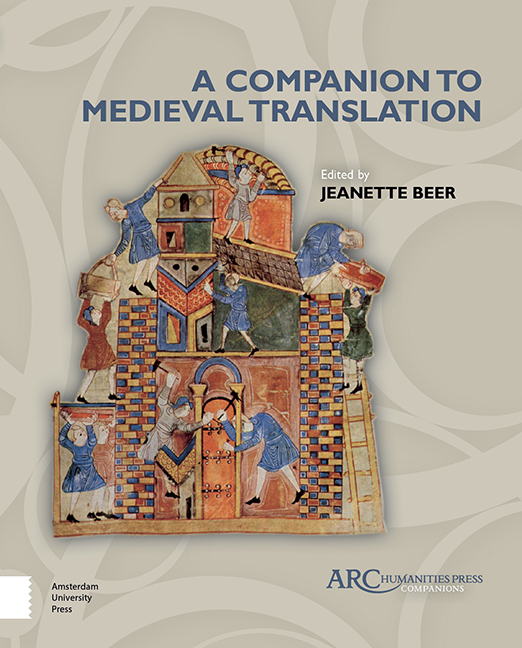Book contents
- Frontmatter
- Contents
- Acknowledgements
- Introduction
- Chapter 1 The European Psalms in Translation
- Chapter 2 The Old French Bible
- Chapter 3 Middle English Religious Translation
- Chapter 4 Bible Translation and Controversy in Late Medieval England
- Chapter 5 Medieval Convent Drama: Translating Scripture and Transforming the Liturgy
- Chapter 6 Translating Romance in Medieval Norway: Marie de France and Strengleikar
- Chapter 7 Christine de Pizan, Translator and Translation Critic
- Chapter 8 Translation, Authority, and the Valorization of the Vernacular
- Chapter 9 Vernacular Translation in Medieval Italy: volgarizzamento
- Chapter 10 Dante and Translation
- Chapter 11 Chaucer and Translation
- Chapter 12 Alchemy and Translation
- Chapter 13 Scientific Translation: A Modern Editor’s Perspectiv
- Chapter 14 Modern Theoretical Approaches to Medieval Translation
- Chapter 15 Observations on Translation by a Thirteenth-Century Maître: Li Fet des Romains
- Epilogue. Observations on Translation by the Oxford Professor of Poetry: Pearl
- General Bibliography
- Appendix
- Index
Chapter 5 - Medieval Convent Drama: Translating Scripture and Transforming the Liturgy
Published online by Cambridge University Press: 20 November 2020
- Frontmatter
- Contents
- Acknowledgements
- Introduction
- Chapter 1 The European Psalms in Translation
- Chapter 2 The Old French Bible
- Chapter 3 Middle English Religious Translation
- Chapter 4 Bible Translation and Controversy in Late Medieval England
- Chapter 5 Medieval Convent Drama: Translating Scripture and Transforming the Liturgy
- Chapter 6 Translating Romance in Medieval Norway: Marie de France and Strengleikar
- Chapter 7 Christine de Pizan, Translator and Translation Critic
- Chapter 8 Translation, Authority, and the Valorization of the Vernacular
- Chapter 9 Vernacular Translation in Medieval Italy: volgarizzamento
- Chapter 10 Dante and Translation
- Chapter 11 Chaucer and Translation
- Chapter 12 Alchemy and Translation
- Chapter 13 Scientific Translation: A Modern Editor’s Perspectiv
- Chapter 14 Modern Theoretical Approaches to Medieval Translation
- Chapter 15 Observations on Translation by a Thirteenth-Century Maître: Li Fet des Romains
- Epilogue. Observations on Translation by the Oxford Professor of Poetry: Pearl
- General Bibliography
- Appendix
- Index
Summary
At the centre of medieval Christendom in the West was the Latin Vulgate Bible, to varying degrees inaccessible to the many people— the laity, conversi, and some women religious— who received little or no Latin training and who, even if they could recite passages of Latin liturgy, sometimes had only the most pragmatic understanding of the language, in the most specific liturgical contexts. Vernacular drama was a particularly effective tool for teaching Scriptural narratives and their Christological significance, at the same time as encouraging appropriate affective responses in an audience of believers; vernacular drama also offered a gloss on the biblical stories that were the primary influence on the Latin liturgy. This chapter considers a specific example in which biblical material moves through time and space through the medium of dramatic representation in the fifteenth-century medieval convent; it will explore the outcomes of the interpretation and transformation of scripture through its translation into dramatic form, and consider the adaptation and transmission of the resulting material into the seventeenth century.
Like civic Scriptural drama, nuns’ plays translated Vulgate Latin into the vernacular in order to teach biblical narrative; also like civic drama, but perhaps to an even greater degree, convent drama referenced liturgical elements to explain their function. The objective of the liturgy was the worship of God and petition directed heavenward: medieval congregations may not have contributed to its words or action but they were thoroughly engaged in the intention of the celebration. Medieval plays complicate neat distinctions between performers and spectators that characterize later theatre, and convent plays blur distinctions between actors and audience much further, as in some cases there may have been nobody watching who was not also performing, and if there were “audiences” then their responses— active, as well as affective— were integrated into the work of the plays. Scriptural plays written and performed by medieval nuns necessarily differed from plays written for the medieval city street because they were performed in contexts that were inaccessible to the general public, and free from the influence of civic authorities for whom public playing was an opportunity for the display of power and prestige.
- Type
- Chapter
- Information
- Companion to Medieval Translation , pp. 63 - 74Publisher: Amsterdam University PressPrint publication year: 2019



